The post Bold Journey: Interview with Scott Mills appeared first on Droidcure.
]]>We caught up with the brilliant and insightful Scott Mills, Droidcure Developer and CoFounder, a few weeks ago and have shared our conversation below.
Scott, we’re thrilled to have you on our platform and we think there is so much folks can learn from you and your story. Something that matters deeply to us is living a life and leading a career filled with purpose and so let’s start by chatting about how you found your purpose.
That’s a good question. It really came from a combination of a personal need and a long-standing passion for creating and developing new tools and systems. When my sister was diagnosed with cancer, it hit home for me how important it was for her to have a trustworthy source of medicine. I started growing my own cannabis, and while that was the initial catalyst, I realized my purpose was bigger than just that—it’s about using my skills to create and to make people’s lives easier—whether that’s helping my sister feel better throughout treatment, or making the tedious parts of growing easier for home cultivators.
Growing cannabis was a labor of love, but the curing? That was a headache. I had this ridiculous number of jars, endless burping, and I was constantly worried I’d ruin all my hard work. As someone who loves to travel, I hated being tied to my home just to babysit jars. That’s when I had the “a-ha” moment: what if there was a way to automate this whole process? I was driven to a point of pure frustration and realized there wasn’t a single product out there that did exactly what I needed. That was the seed for Droidcure, and it aligned perfectly with my purpose to create solutions and make life easier.
Even once I had the idea, I had to fight my imposter syndrome. I love to create, but designing a professional product with components and PCBs was new for me. The first Droidcure was hand-soldered, and when I moved on to designing circuit boards for manufacturing, I hit a wall. I felt like I just didn’t have the knowledge and was ready to give up. But a friend in the industry looked at my work and told me I was on the right track; I just needed a fresh perspective. He taught me so much. I overcame that by surrounding myself with people smarter than me—people who could teach and help me grow. And, of course, lots of late-night research and books, all fueled by my love for learning.
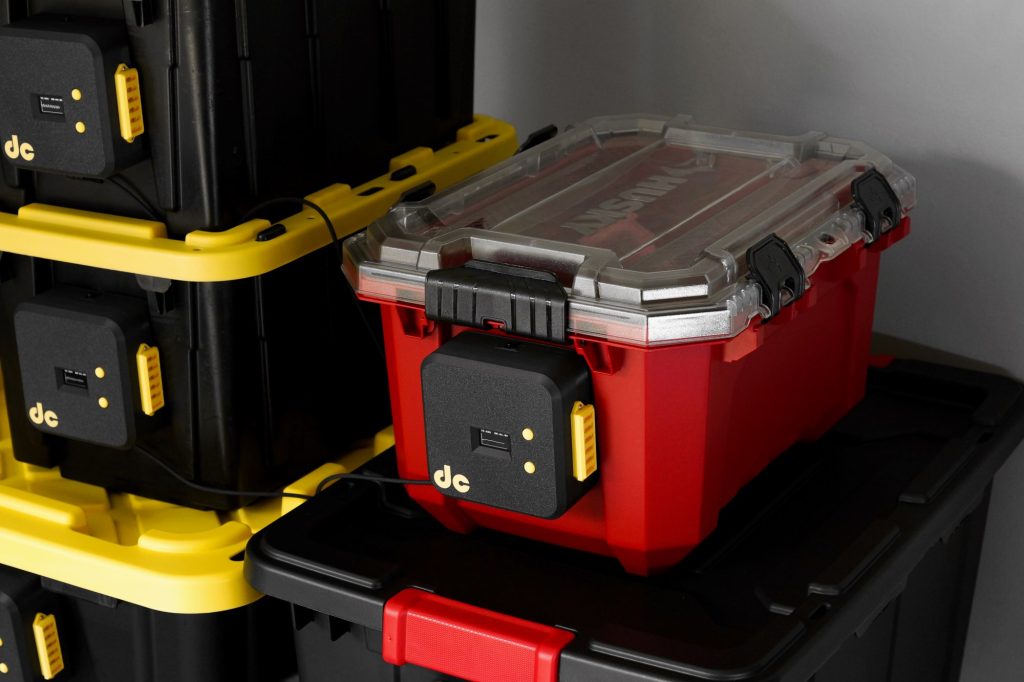
Let’s take a small detour – maybe you can share a bit about yourself before we dive back into some of the other questions we had for you?
My professional story with Droidcure really began with that personal pain point, which became the basis for a business. What’s so exciting and special about Droidcure is how it directly solves that problem. It takes away the stress of the curing process and gives people back their time. It’s a highly accurate tool, which is something that has normally been inaccessible to home growers. We are changing that.
For me, the most inspiring moment wasn’t creating the first prototype, but seeing the early feedback from other people who got their hands on it. I knew Droidcure worked for me, but seeing it work for others, hearing how they loved how accurate and easy it was to use—that was truly special.
My goal was always to create a product that was high-quality and took away the stress of the curing process. We believe growing is about nurturing life, not babysitting your cure, and that belief has been validated over and over again. People can now focus on the fun parts of the grow, knowing they’ll get a consistent, premium end product every single time.
And this is just the beginning. I’m always thinking about what’s next in the product pipeline. We’re already developing more solutions, with some exciting things coming soon that are designed to make the growing and post-harvest process easier and more accessible for everyone.
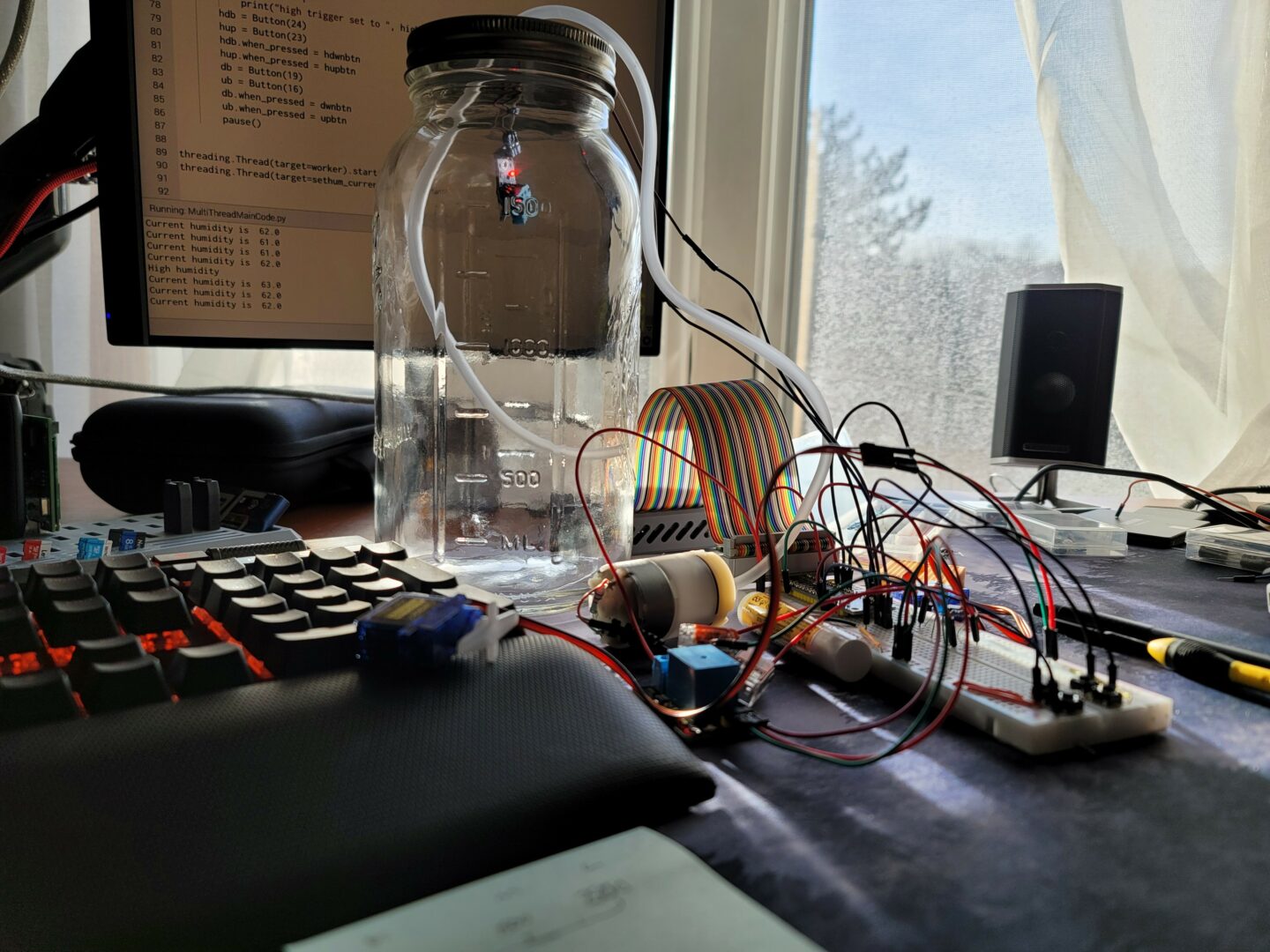
If you had to pick three qualities that are most important to develop, which three would you say matter most?
I’d say the three most impactful qualities for me have been persistence, curiosity, and the willingness to ask for help.
First, persistence. Specifically, persistence in gathering data. It’s a skill I picked up from both my biological and adopted dads. It’s all about analyzing something, getting your data points, and then analyzing it all over again. You keep doing that until you get consistent results. That’s when you know you can finally do something with that information. This isn’t just about Droidcure; it’s a life skill. It’s about not settling for one answer—and believing that you don’t fully know something until you get the same results over and over again. This has helped us make Droidcure the best it can be, and it helps in every other part of life, from automating our grow operations to my other passions. It’s a truly enlightening way to make truths about your environment.
Second, curiosity. My personal struggles with insomnia and ADHD meant I often had all-night research sessions, which led me to dive deep into everything about cannabis. That curiosity is what led me to question the status quo of curing and ultimately to create Droidcure. My advice is to never stop being curious. If something seems inefficient or you don’t understand it, dive in and learn.
Finally, the willingness to ask for help. When I hit that wall with designing the PCBs, it was a friend who helped me see I was on the right track. I overcame my imposter syndrome by surrounding myself with people smarter than me; people who could teach me and help me grow and ultimately find my confidence. My advice here is to let go of your ego. You don’t have to know everything. Find people who are great at what they do, listen to them, and learn from them. It’s the fastest way to grow.
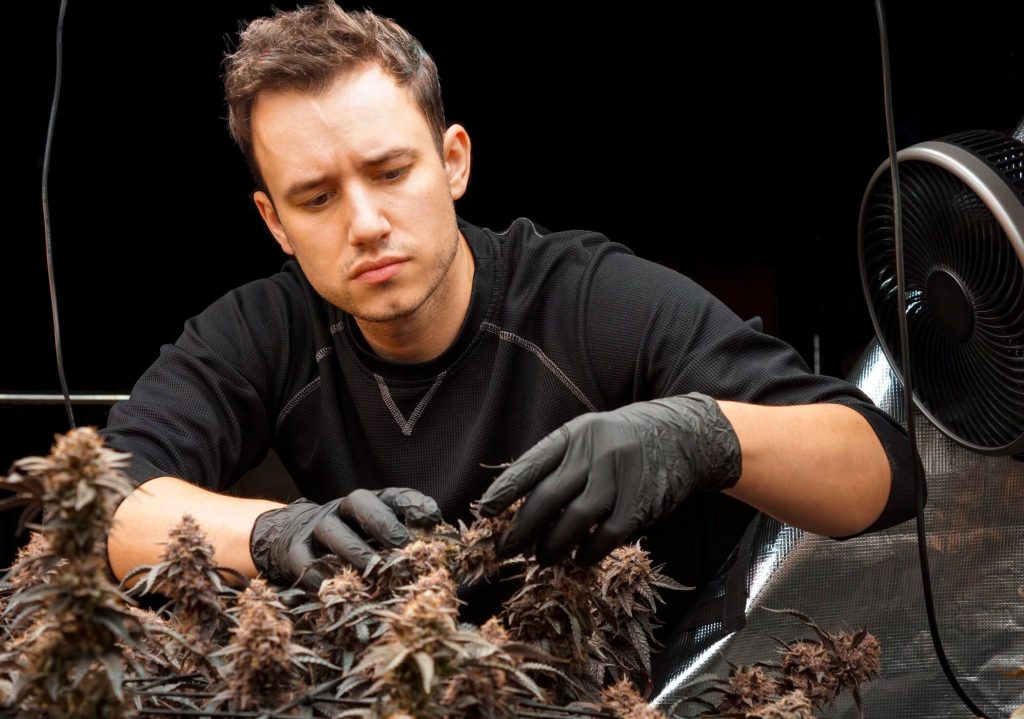
How can folks who want to work with you connect?
Absolutely! Our vision is to get Droidcure into the hands of all home growers and small commercial craft growers who would benefit from high-quality solutions that don’t break the bank. We’re always looking to collaborate with stores that share our values and help us share knowledge with customers who want to garden and grow. Those interested in getting in touch can email me at [email protected].
The vision is bigger than just Droidcure, though. We want to collaborate with other like-minded engineers to provide other products that are on par with or even better than what’s currently available but are more accessible. We want to do better for the growing community as a whole. Ultimately, we’re here to help people grow with confidence, and we want to find people who are just as passionate about that as we are.
Contact Info:
- Website: droidcure.com
- Instagram: www.instagram.com/droidcure
- Facebook: www.facebook.com/droidcure
- Email: [email protected]
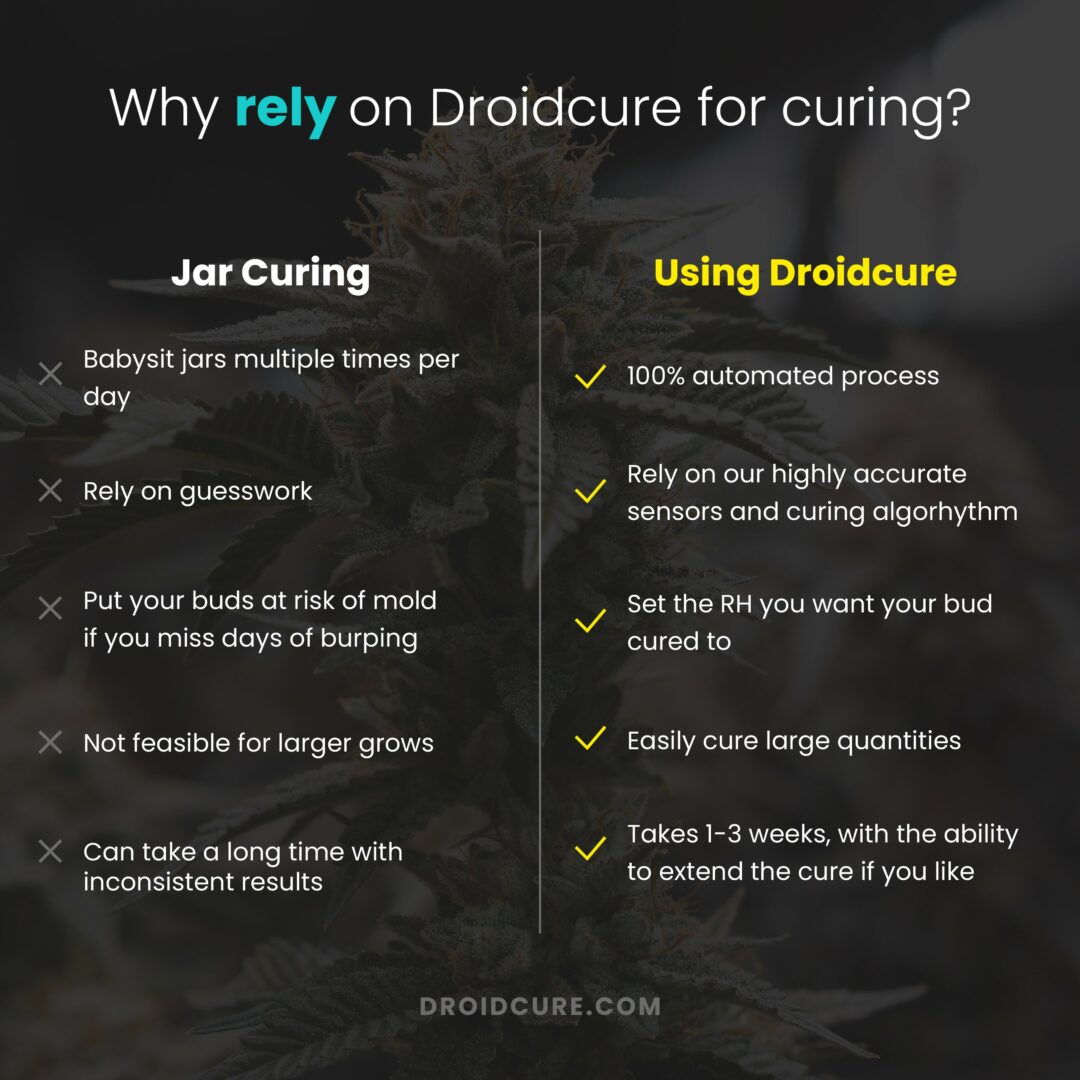
The post Bold Journey: Interview with Scott Mills appeared first on Droidcure.
]]>The post Droidcure Automated Curing Now Available for Cultivators In Australia and New Zealand appeared first on Droidcure.
]]>This new collaboration is a game-changer for our customers in Australia and New Zealand. By teaming up with Green Genius, we can now offer faster shipping, local support, and dedicated sales expertise, ensuring a smoother experience for you.
What This Partnership Means for You
This partnership makes it easier than ever for our Australian and New Zealand customers to get their hands on Droidcure products. While the price is slightly higher to cover international shipping and import fees, this change makes the entire purchasing process far more convenient.
- For our customers in Australia & New Zealand: You can now buy our automated curing devices directly from Green Genius. Please note that prices on their site are in AUD.
- For our customers in the USA & Canada: Your purchasing process remains the same. You can continue to find Droidcure products on our website, www.Droidcure.com.
- For all other international customers: Please continue to reach out to us directly at [email protected] with any questions or inquiries. We are always happy to help!
We are incredibly excited about this new chapter and believe it will allow us to better serve our growing community worldwide.
The post Droidcure Automated Curing Now Available for Cultivators In Australia and New Zealand appeared first on Droidcure.
]]>The post A Harvest of Connections: Key Takeaways From Minnesota’s 2nd Annual Doobie Dabbler appeared first on Droidcure.
]]>We felt so energized connecting with all of you and sharing how Droidcure can take the frustration and guesswork out of the curing process to deliver consistent, top-tier results.
We heard the same great questions repeatedly, so we wanted to share the answers—and a few things that got people the most excited.
Your Top 3 Questions, Answered
How does it work? Droidcure automates the entire curing process, removing the guesswork from start to finish. After drying your flower, simply attach Droidcure to a tote, toss in your harvest, and set your desired relative humidity (RH) level. The device then takes over, slowly and algorithmically burping the tote until the moisture has stabilized at your preferred level.
What size container can Droidcure handle? Droidcure can handle containers up to 27 gallons, making it perfect for both home growers and large-scale cultivators. You can choose the size that best fits your harvest. Here’s an article about selecting your tote.
How long does it take? While every cure is different, most are complete within 1 to 3 weeks, with 2 weeks being the most common. The time can vary depending on bud density and quantity. For smaller amounts, it may take less time—and you can add a damp sponge to help slow it down if needed.
Additional FAQ’s can be found on our support page.
The Top 3 Things People Were Most Excited About
 Precision for Every Grower – Many of you were thrilled to learn that Droidcure brings commercial-grade precision and quality control directly to the home grower. You can achieve a level of detail and consistency usually only found in expensive, large-scale cultivation tools.
Precision for Every Grower – Many of you were thrilled to learn that Droidcure brings commercial-grade precision and quality control directly to the home grower. You can achieve a level of detail and consistency usually only found in expensive, large-scale cultivation tools.
 Cost-Effectiveness – We heard a lot of excitement about our ability to offer such a high-quality product at a cost-effective price. You can get professional, perfect results for your harvest without breaking the bank.
Cost-Effectiveness – We heard a lot of excitement about our ability to offer such a high-quality product at a cost-effective price. You can get professional, perfect results for your harvest without breaking the bank.
 Unmatched Support – Perhaps the biggest takeaway was your appreciation for our commitment to customer support. When you buy Droidcure, you don’t just get a product; you get a partner who is here to ensure you get a perfect cure every time.
Unmatched Support – Perhaps the biggest takeaway was your appreciation for our commitment to customer support. When you buy Droidcure, you don’t just get a product; you get a partner who is here to ensure you get a perfect cure every time.
We are so grateful for all the conversations we had and can’t wait to help you transform your harvest!
Do you have more questions about the curing process or Droidcure? Send us an email at [email protected].
The post A Harvest of Connections: Key Takeaways From Minnesota’s 2nd Annual Doobie Dabbler appeared first on Droidcure.
]]>The post How to Select the Best Curing Tote for Your Droidcure appeared first on Droidcure.
]]>One of the most foundational decisions for a successful cure, especially when leveraging the precise humidity control for cannabis curing offered by your Droidcure device, is selecting the ideal curing container.
device, is selecting the ideal curing container.
Not all containers are created equal, and the choice you make can significantly impact how smoothly your cure goes. Let’s dive into the world of curing totes and explore the best options to ensure your Droidcure can work its wonders, leading to a truly exceptional cure.
Key Factors for Selecting Your Cannabis Curing Container
To ensure optimal results with your Droidcure, consider these five crucial factors when choosing your cannabis curing tote:
- Curing Tote Size (Gallons)
- Airtightness
- Tote Shape for Droidcure Mounting
- Food-Grade Material
- Curing Chamber Wall Width
Let’s dive into each of them:
Curing Tote Size
For your Droidcure to effectively manage humidity, choose a curing tote between 5 and 27 gallons. This range allows the pump to exchange air properly. While slightly larger totes can be used, the pump may overwork, potentially shortening its lifespan. A tote that’s excessively large may also put your bud at risk of molding if air can’t exchange fast enough.
Sticking to the 5 to 27-gallon range ensures optimal air exchange and device longevity.
Airtightness for Precise Cannabis Curing
An airtight seal on your curing tote is paramount for minimizing any unwanted exchange of air with the external environment. This crucial feature prevents the loss of the carefully regulated humidity levels for curing cannabis created by your Droidcure, ensuring the device operates efficiently and your cannabis cure progresses at the desired pace. Reputable brands like Husky offer airtight storage containers in various suitable sizes.
Prioritizing an airtight cannabis curing container becomes especially important for those in consistently dry environments, such as Colorado year-round or during northern winters. Without a tight seal, dry ambient air can easily infiltrate the curing chamber and lead to overly rapid drying of your buds.
If you’re able to regulate your lung room’s RH to stay just below where you’re trying to cure to, airtightness becomes less critical. For more budget-friendly options, consider using an HDX brand tote. If air leakage becomes an issue, you can easily enhance its seal by installing weather stripping tape around the lid.
Tote Shape for Mounting
For a secure and stable attachment of your Droidcure device, your curing tote must have a flat surface measuring at least 4.5 inches by 4.5 inches that you can drill into using a 4 inch hole saw. This flat area is essential for the Droidcure to mount correctly, typically on the upper portion of the front or side of the cannabis curing container.
Ideally, try to attach the Droidcure on the upper part of the side. This maximizes your space for plant material since you shouldn’t cover the fan/sensor.

To simplify your selection process, each Droidcure includes a convenient Tub Template. We highly recommend taking this template with you when shopping at your local hardware store to ensure any potential curing tote offers a compatible flat area for secure mounting.
Food-Grade Material
We strongly recommend using a tote or container made from food-grade material for your cannabis curing. Popular brands like Husky, HDX, and many Sterilite totes offer food-grade options.
Choosing a food-grade container ensures that no harmful chemicals will leach into your valuable cannabis during the curing process, preserving its quality, aroma, flavor, and safety for consumption. Always look for clear labeling or certifications on the company’s website indicating that the storage tote is safe for food contact.
Even with food-grade totes, it’s worth noting that some manufacturers utilize release agents during the molding process. These substances help the plastic product detach easily from the mold. It’s a prudent step to thoroughly wash your new food-grade tote with warm water and dish soap before its first use. After washing, ensure the tote is completely dry before introducing your dried cannabis and Droidcure device. This simple precaution will provide an extra layer of assurance for a clean and pure curing environment.
Curing Chamber Wall Width
While most standard storage totes and plastic containers will work perfectly with your Droidcure, if you are considering using a non-standard curing chamber option, such as a small wine fridge, it’s crucial to ensure that the walls are less than 11 millimeters (mm) thick. This limitation ensures that the Droidcure mounting screw can securely attach the device to your chosen curing container.
Wrapping Up: Selecting the Ideal Container for Cannabis Curing with Droidcure
Selecting the right vessel is a key first step in your curing journey with Droidcure. By keeping size, airtightness, shape for mounting, and food-grade material in mind, you’ll create the ideal environment for your buds to reach their full potential.
With the right tote as your foundation, your Droidcure can work its magic, ensuring a flavorful, aromatic, and perfectly preserved harvest.
Happy growing and curing!
Still have questions? Reach out to us at [email protected] for additional support.
The post How to Select the Best Curing Tote for Your Droidcure appeared first on Droidcure.
]]>The post Beyond Indica and Sativa: The Terpene Revolution in Cannabis appeared first on Droidcure.
]]>The Limitations of Indica and Sativa Classifications
Historically, Indica and Sativa classifications were based largely on the plant’s morphology. “Indicas” were characterized by their broad leaves and relaxing effects, while “sativas” were associated with their narrow leaves and stimulating effects.
While those broad definitions can be true and seem reliable to some extent, scientific research has revealed that this simple dichotomy fails to capture the complex interplay of compounds within cannabis.
Compounding the issue of this simplistic classification, pure indica or sativa strains are becoming increasingly rare. As breeding takes off, the modern cannabis market is dominated by hybrids. This makes relying solely on these broad classifications even less reliable for predicting effects.
We can do better!
The Rise of Terpene Awareness
Terpenes, found in various plants and even some animals, are the aromatic compounds that give them their unique scents, tastes, and even appearances.
Cannabis boasts a diverse array of terpenes that exhibit various therapeutic attributes, including analgesic, anti-anxiety, and anti-inflammatory effects. This contributes to the plant’s potential use in managing pain, anxiety disorders, and inflammatory conditions.
Consumers are more empowered than ever to explore and discover specific profiles that align with their personal preferences and desired experiences, whether for therapeutic purposes or simply to enhance well-being and enjoyment.
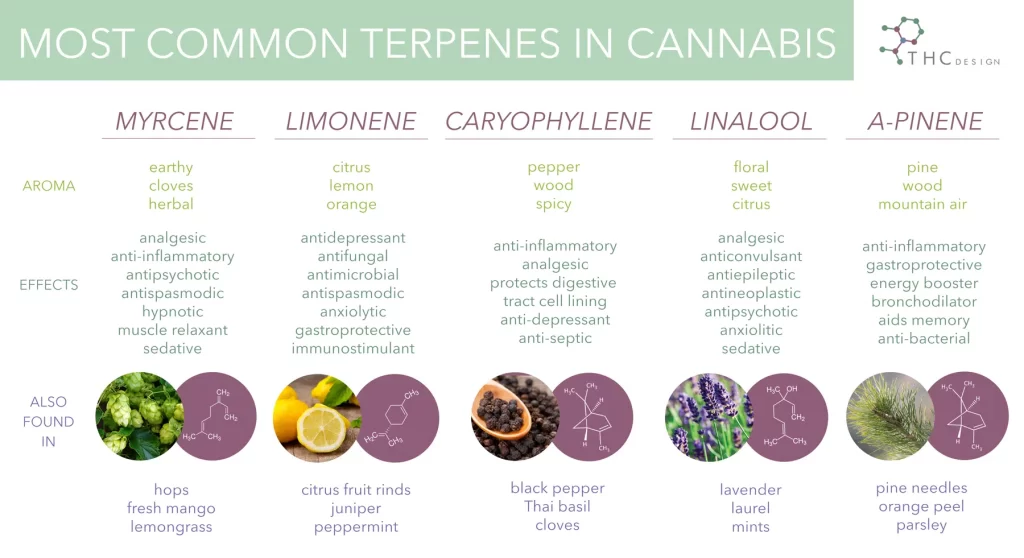
There are plenty of resources available that dive more into the benefits of each terpene, like this article by THC Design.
As our knowledge about the effects of terpenes grows, so too does the availability of testing for them. Companies like Manitou Analytical and Smarti Plantz are emerging to provide mail-in terpene testing, so growers can be more aware of the intricate chemical profiles of their harvests. Not long ago, this level of detail was largely inaccessible to the average consumer or home grower.
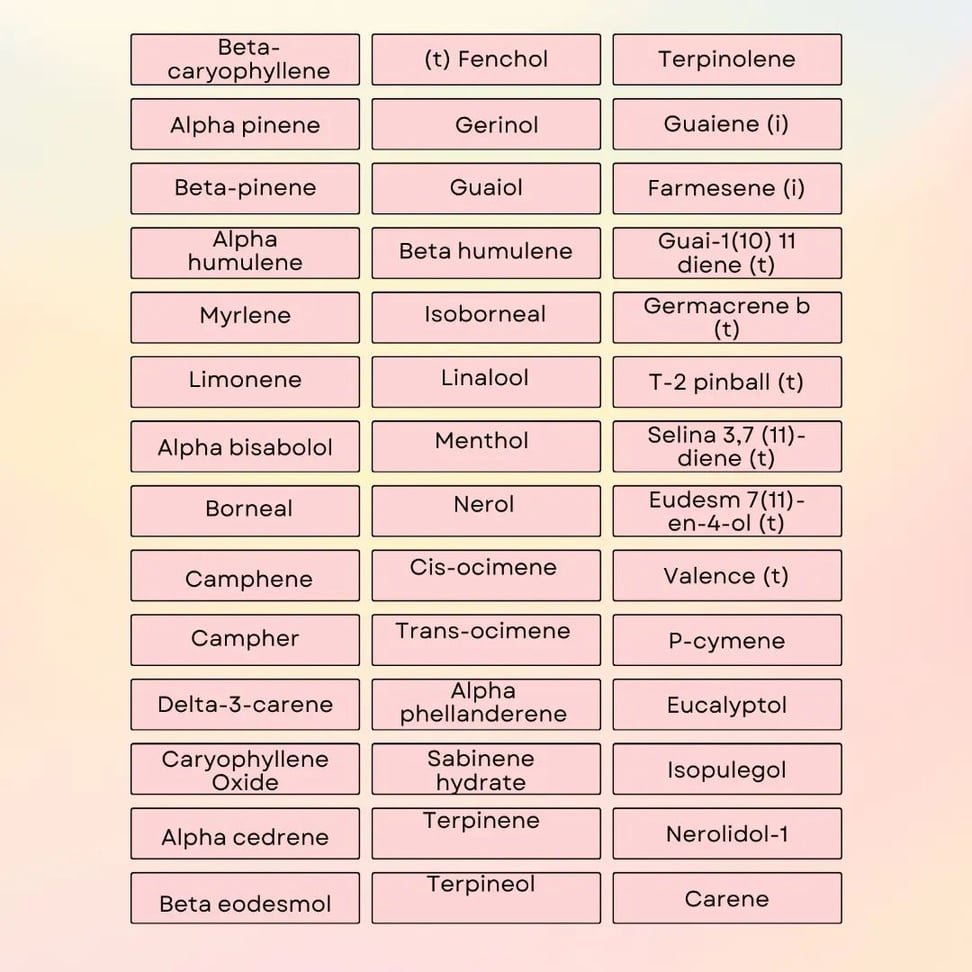
Adding to the complexity, the 200+ terpenes found in cannabis interact synergistically with 100+ cannabinoids like THC and CBD, a phenomenon known as the “entourage effect,” to modulate the overall experience.
A More Nuanced Approach
This shift towards terpene awareness is empowering consumers to:
Personalize their experience: By understanding the specific effects of different terpenes, individuals can choose cannabis products that align with their desired outcomes.
Move beyond generalizations: By focusing on terpene and cannabinoid profiles, consumers can move away from the unreliable “indica” and “sativa” classifications.
Enhance therapeutic potential: The therapeutic applications of cannabis are becoming increasingly refined as researchers uncover the specific roles of individual terpenes.
The Future of Cannabis Consumption
The future of the cannabis industry lies in a deeper understanding of the plant’s chemical complexity. As research continues to unravel the intricate relationships between cannabinoids and terpenes, we can expect to see:
- More precise product labeling, with detailed terpene profiles.
- The development of targeted cannabis therapies, tailored to individual needs.
- Increased consumer education, empowering individuals to make informed choices.
- Continued and expanded research into the complex interactions between cannabinoids, terpenes, and other phytochemicals is essential to fully understand and utilize the plant’s potential.
The terpene revolution is transforming the cannabis landscape, ushering in an era of personalized and precise consumption. By embracing this new understanding, we can unlock the full potential of this remarkable plant.
The post Beyond Indica and Sativa: The Terpene Revolution in Cannabis appeared first on Droidcure.
]]>The post Inspiring Conversations with Scott Mills of Droidcure by Voyage Minnesota appeared first on Droidcure.
]]>Today we’d like to introduce you to Scott Mills.
Hi Scott, it’s an honor to have you on the platform. Thanks for taking the time to share your story with us – to start maybe you can share some of your backstory with our readers?
My story, like many innovators, started with a personal frustration. I have been a cannabis home grower for many years. I love the process of nurturing these plants and seeing each strain develop in their own unique ways, but the post-harvest curing phase had been a struggle.
For those who are unfamiliar, curing is a necessary post-harvest step where moisture is stabilized and chemical compounds slowly break down and off-gas, which ultimately helps the smoothness and flavor of the smoke.
I was manually curing in jars, burping them daily—opening them to release built-up gas. It wasn’t unbearable, but it tethered me to home and relied heavily on guesswork, revealing a glaring lack of precision in this crucial step.
I needed a simple, reliable way to automate curing, initially just for myself. I built a prototype, shared it on Reddit, and the reaction was intense. People bluntly told me to “take this down and patent it immediately”. I knew I was onto something.
From there, it was a whirlwind of development, patenting, and launching Droidcure. It’s been a wild ride, and I’m still learning every day.

Alright, so let’s dig a little deeper into the story – has it been an easy path overall and if not, what were the challenges you’ve had to overcome?
I admit, it’s been a little bumpy. Launching an invention with zero outside investment is a constant uphill battle. That has probably been the biggest obstacle.
There’s also the technical challenge of perfecting the product, the manufacturing hurdles, and the sheer amount of work involved in building a brand from scratch. There were countless nights spent troubleshooting, refining, and figuring out how to make Droidcure as user-friendly and reliable as possible.
Another struggle for entrepreneurs that doesn’t get talked about enough is overcoming the initial self-doubt. When you’re building something new, you’re constantly questioning yourself. But the positive feedback from the community has inspired me and kept me going.
Alright, so let’s switch gears a bit and talk business. What should we know?
Droidcure is all about simplifying the cannabis curing process for home growers. We specialize in automated moisture stabilization, taking the guesswork and hassle out of curing.
Plant material naturally tries to balance its moisture with the air around it. Droidcure uses algorithms to manage that balance, accurately curing the plant material to a target relative humidity of the user’s choice, between 57-66% RH.
What sets us apart is our focus on simplicity and reliability. We designed Droidcure to be incredibly easy to use, with no internet or cloud connectivity for maximum privacy. It just works. You set your target humidity, connect it to your curing chamber – whether it’s a storage tote or a wine fridge – and it takes care of the rest. Plus, it’s energy-efficient and reduces single-use plastics such as grow bags; we value being as environmentally friendly as we can.
I’m very proud of the fact that Droidcure solves a real problem for home growers. It gives them back their time and peace of mind. We’re not just selling a product; we’re offering a solution that allows people to enjoy the full experience of growing their own medicine without the risks that come along with curing.
We want readers to know that Droidcure is built with the home grower in mind – it’s reliable, affordable, and designed to make your life easier.
Where we are in life is often partly because of others. Who/what else deserves credit for how your story turned out?
First and foremost, my co-founder and partner, Natalie Hilscher, has been instrumental in our success. Her experience in marketing and unwavering support these past few years have been invaluable.
Then there are Bob and Erin at CannaJoyMN, seed bank in Minneapolis. They took a chance on Droidcure early on, and their enthusiasm and support have been a huge boost to our visibility. They’ve been amazing advocates in the community.
And of course, we can’t forget the Reddit community! Those initial reactions gave me the push I needed to take this idea seriously.
Lastly, the constant stream of feedback from users has helped us refine and improve Droidcure. It’s a testament to the power of community, and I’m incredibly grateful for everyone who’s been a part of this journey. Thank you for supporting us, and in return we plan to continue supporting you!
The post Inspiring Conversations with Scott Mills of Droidcure by Voyage Minnesota appeared first on Droidcure.
]]>The post Relative Humidity vs. Temperature: A Cannabis Curing Conundrum appeared first on Droidcure.
]]>RH refers to the amount of water vapor in the air compared to the maximum amount of water vapor the air can hold at a specific temperature.
Think of it like a sponge. A dry sponge can absorb a lot of water. As it gets more saturated, it can’t hold as much additional water. Similarly, as air gets colder, it isn’t capable of holding as much additional moisture.
So, if you have a jar of plant material stabilized to a certain RH and you change the temperature, the RH reading will change even though the actual amount of moisture in the jar hasn’t changed.
The Impact on Cannabis Curing
Curing is a critical process that involves slowly drying and moisture-stabilizing the cannabis to make it safe for long-term storage, which also improves the flavor and smell by breaking down compounds like chlorophyll.
During this process, it’s essential to maintain a specific RH level to prevent mold and mildew growth while allowing the plant material to cure properly. Understanding the relationship between temperature and RH is necessary for getting your ideal cure in your specific lung room and storage environments.
One common way growers are affected is when curing in a cooled environment (like in a refrigerator/cooler) then bringing the cannabis back up to room temperature for consumption. When bringing cool cannabis back up to room temperature, you will likely notice a slight decrease in the RH reading.
This doesn’t mean that the cannabis has suddenly become drier. It simply means that the warmer air can now hold more moisture, so the relative humidity reading drops.
We highly recommend you keep the temperature in your lung room as stable as possible throughout your entire curing process to avoid any confusion.
Applying the Concept
The difference in RH is surprisingly significant at varying temperatures:
- Cannabis cured at 55°F to 62% RH will become 36.6% RH at 70°F
- Cannabis cured at 60°F to 62% RH will become 43.8% RH at 70°F
- Cannabis cured at 65°F to 62% RH will become 52.2 RH at 70°F
- Additionally, the chart below shows how cannabis cured at 65°F changes when exposed to different temperatures. You can see that cannabis cured at 65°F to 60% RH will change to 42.7% RH when brought up to 75°F.
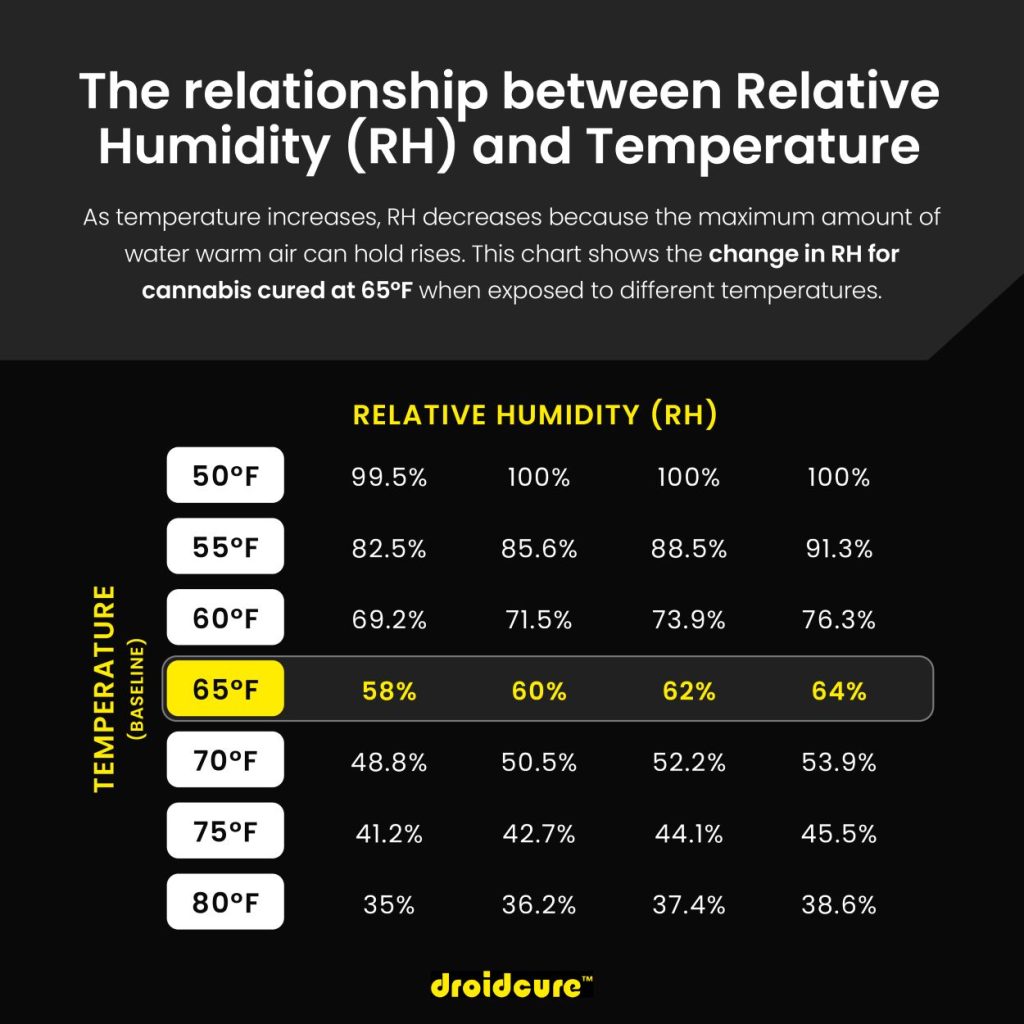
You can play around with more RH and temperature conversions at https://www.markusweimar.de/en/humidity-calculator/
The post Relative Humidity vs. Temperature: A Cannabis Curing Conundrum appeared first on Droidcure.
]]>The post Revive Overdried Cannabis: A Simple Guide to Rehydration for Curing appeared first on Droidcure.
]]>Drying cannabis is a crucial step in the post-harvest process, but it’s easy to go too far especially if you’re busy or have to leave town for a few days. If your flower is feeling crispy and dry, don’t worry. There’s a simple method to rehydrate them without sacrificing quality.
Enter the Droidcure and Cellulose Sponges
Using a device like the Droidcure, you can effectively rehydrate overdried buds. Here’s how:
1) Prepare the Sponges: Wet cellulose sponges with reverse osmosis (RO) or distilled water to avoid microbial growth and salt buildup. Make sure to wring them out thoroughly. You may even want to cut the sponge in half, so it creates less moisture in your curing chamber and rehydrates them more slowly. (If you can’t get cellulose sponges, use a paper towel that’s wrung out well.)
2) Set the Droidcure: Place the overdried flower in the Droidcure and insert the wet sponges in the back of the chamber, not touching your flower. Set the humidity to 66% until moisture appears stabilized (chart line should be straight across, and you may see “cure finished” message).
3) Adjust Humidity: After stabilizing at 66%, remove the sponges and lower the humidity to 62%. (If you’re trying to end your cure above 62%, set it to that value instead.)
4) Finish the Cure: Finish your cure to your desired relative humidity. You can leave them at 62%, or cure them to a slightly lower humidity like 59%.
By following these steps and using the Droidcure, you can effectively rehydrate overdried cannabis and enjoy a high-quality product. Remember, a little experimentation can go a long way in perfecting your growing and curing process.
We encourage home growers to share their experiences with this method. Your feedback can help others learn and improve their curing techniques!
Which bins are pictured?
The HDX 14-gallon tote paired with two 8″ x 14″ Design Ideas Meshworks stacking bins creates a tidy storage solution and allows growers to separate strains in the curing chamber.
The post Revive Overdried Cannabis: A Simple Guide to Rehydration for Curing appeared first on Droidcure.
]]>The post Dialing in your Cannabis Cure for Specific Uses: Rosin, Smoking, & Storage appeared first on Droidcure.
]]>The post-harvest process is a critical step in maximizing the quality of your cannabis.
It involves drying the flowers slowly and evenly then stabilizing moisture with your cure, allowing the chlorophyll to break down and the buds to develop the unique flavors and aromas we associate with cannabis.
The ideal moisture content varies depending on your intended use.
And thankfully, Droidcure makes it incredibly easy to select your target relative humidity based on what you want to do:
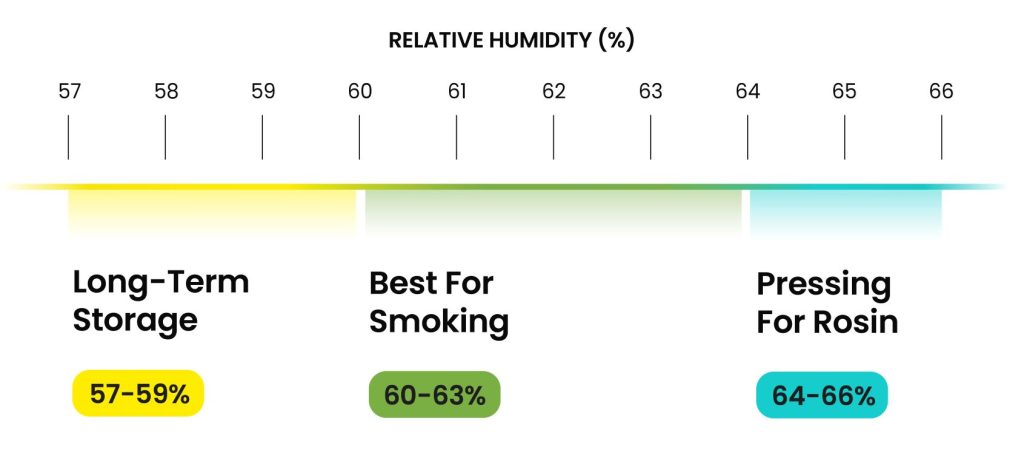
How to Cure Cannabis for Rosin
For pressing cannabis buds to extract rosin, a slightly higher moisture content is beneficial. The moisture prevents the extracted oil from wicking back into the plant material, ensuring that the resin remains concentrated and is easier to extract. Set your Droidcure to around 64-66% humidity to aid in the extraction of THC and other cannabinoids.
Additional tips for pressing:
- Use a high-quality rosin press
- Apply even pressure to the buds
- Avoid over-squishing, as this can result in lower-quality rosin
- You can rehydrate your flower if it’s already below 64-66% RH
- If you’re in the MN Twin Cities metro area, consider renting a rosin press from Reefer Rentals for easy, hassle-free pressing. (We’ve rented their press before and can vouch for them!)
Curing for Everyday Use
If you’re planning to store your cured cannabis in a jar for everyday smoking or vaping, a slightly lower moisture content is ideal. This prevents the buds from becoming too sticky or getting moldy.
Aim for a target cure of around 60-63%. This will ensure that the cannabis is dry enough to smoke or vape smoothly, while still retaining their flavor and potency.
Additional tips for everyday use:
- Store cured cannabis in a cool, dark place for the best preservation
- Use an airtight jar to prevent moisture loss, like a stainless steel or glass jar
- Open your jar as little as possible, and for only short periods of time
- Consume within a reasonable timeframe to maintain optimal quality
Curing for Long-Term Storage
For long-term storage, it’s essential to keep the moisture content as low as possible, within reason. This helps to prevent the breakdown of cannabinoids and terpenes, preserving the quality of the cannabis over time. Set your Droidcure to 57-59% humidity.
A lower moisture content also helps prevent the breakdown of cell walls, ensuring that your cannabis remains safe and potent for years to come. Use oxygen absorbers in the storage container to minimize oxidation and keep your flower close to perfect for a very long time.
With Droidcure, you also have the option to rehydrate your flower back up to your ideal relative humidity later on.
Additional tips for long-term storage:
- Consider freezing cured cannabis for extended storage
- Periodically check for signs of degradation or mold
- Use vacuum-sealed bags or containers for optimal preservation
Remember, these are general guidelines, and the optimal moisture content may vary depending on the specific strain, growing conditions, and your personal preferences. Experiment with different settings to find what works best for you!
The post Dialing in your Cannabis Cure for Specific Uses: Rosin, Smoking, & Storage appeared first on Droidcure.
]]>The post Built By Growers, For Growers: About Droidcure Creator Scott Mills appeared first on Droidcure.
]]>When my sister was diagnosed with cancer, she began using synthetic THC pills from the pharmacy to help her cope with the treatments. I also didn’t want her using cannabis from some random person (not knowing their growing environment or chems used) while she had a compromised immune system from chemotherapy. I felt a dire need to know that she had access to the best possible cannabis medicine for pain, nausea, etc. at a time when access to trustworthy cannabis was not readily available.
Put it this way: would you trust moonshine made in your Uncle Billy’s friend-of-a-friend’s basement? Maybe. But I probably wouldn’t.
The same logic applies to cannabis, only there are so many more variables. There’s a world of difference between a carefully cultivated plant and something grown recklessly, using nutrients containing heavy metals or other harmful chemicals, or pesticides containing actual poison instead of using warrior bugs to kill pest bugs.
I know things have improved, but that initial fear of the unknown shaped my perspective.
That’s why having a connection to your grower is so important to me. Whether it’s a large-scale operation or a home grower like myself, knowing where your cannabis comes from is essential. Home growing is a labor of love. I know exactly what goes into every plant I cultivate, and I want that same peace of mind for everyone.
I didn’t get good at growing overnight. In the beginning, I remember having 2 tiny terracotta pots with the leggiest seedlings you’ve ever seen. My girlfriend’s cat ate one of them. So we grew one spindly plant in a closet (Blue Shark, if I remember correctly) and it produced a bud, like a few grams, but I was so proud and it did the job. It didn’t last very long though, seriously it was like 10 grams of flower with a bad hair cut.
One of the few perks of having insomnia and executive disfunction-type ADHD was that I was able to research cannabis almost every night (all night) and never stopped. Now, I’m so excited to be part of the legalization movement and to share my own contribution to helping other growers like myself.
Throughout my experience with growing, curing was one of my biggest pain points. An annoying amount of jars, endless burping, and the constant worry of ruining my hard work turned what should have been a celebratory moment into a stressful ordeal. As an avid traveler, being tied down during curing was also terrible.
So, I built Droidcure.
At first it was just for myself to solve a need I had. But when I shared it on one of Reddit’s smaller cannabis subs, it was a wake-up call. Hundreds of people telling me to “delete this shit, idiot” and patent my idea? That’s when I knew I was onto something big, especially when I could make it with better sensors than other products and make it myself so the pricing could match what home grow pricing should be. And so I did; I deleted it and got a patent.
Thank you, kind redditors, for the push!
Droidcure isn’t just a product; it’s a solution to a problem that’s been plaguing growers for too long. Growing is about nurturing life, not babysitting jars, or paying commercial prices for subpar equipment.
Launching a new company without any investors is tough, but the incredible support from the growing community keeps us going.
Your belief in Droidcure means the world to us, and we’re committed to making a product that exceeds your expectations.
The post Built By Growers, For Growers: About Droidcure Creator Scott Mills appeared first on Droidcure.
]]>